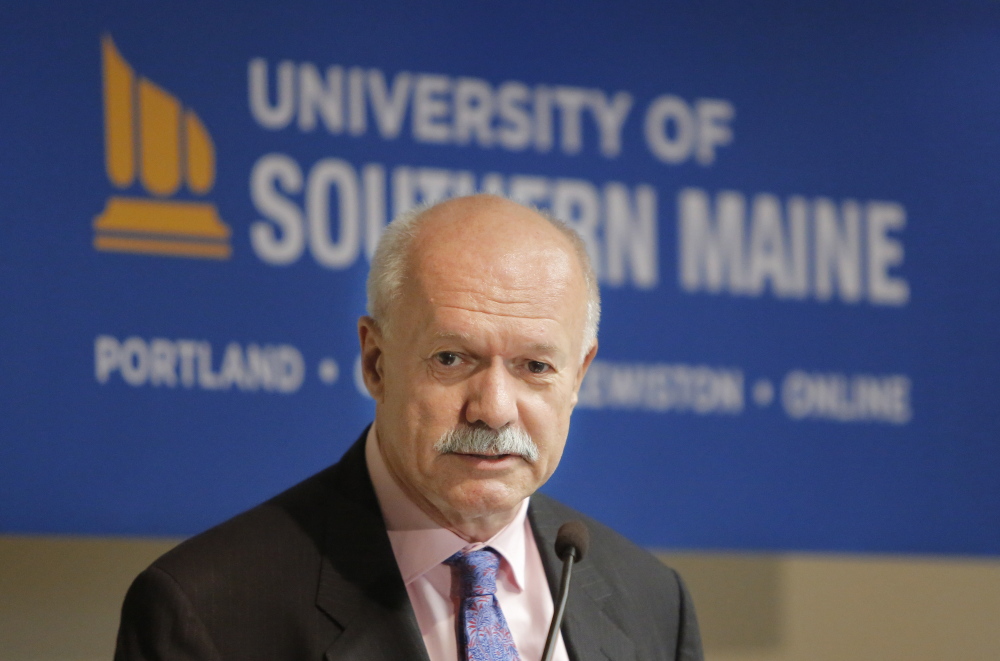Three academic programs at the University of Southern Maine moved a step closer to elimination Friday when the academic affairs committee of the system board of trustees approved the cuts. They now go to the full board for a final vote.
The American and New England studies graduate program, geosciences, and the arts and humanities major at Lewiston-Auburn College, which is part of USM, are set to be eliminated, meaning seven professors could be laid off.
Acting USM President David Flanagan and Provost Joseph McDonnell both emphasized that all three programs were were not being cut because of any concerns with the programs, material or faculty.
“This is a highly contentious issue, a painful issue on this campus, because there is merit on all sides on the quality of these programs,” McDonnell said Friday. “If we were given several years, I believe we could turn some of these programs around with small investments … (but) it would take time and it would take investment which we don’t have.”
“It’s an extraordinarily unfortunate situation that this had not been dealt with earlier,” he said.
The full University of Maine System Board of Trustees is scheduled to vote at its Sept. 21-22 meeting in Fort Kent.
Trustee Bonnie Newsom cast the only “no” vote, saying that as an archaeologist, she couldn’t support cutting American and New England studies.
“I have to admit I have had many sleepless nights over this decision,” Newsom said. “I would be doing my profession a disservice and I’d be doing the people of Maine a disservice.”
The cuts at USM are part of systemwide budget cuts to close a deficit of $36 million that officials say was caused by flat state funding, declining enrollment and tuition freezes. Each of the system’s seven campuses was asked to make deep cuts this year, and more cuts are expected next year.
USM made $7 million in cuts this year, and got $7 million in one-time emergency funds from the system to close a $14 million gap in the $134 million budget for the fiscal year that began July 1.
Flanagan said Friday that USM already faces a $15 million budget gap for the next budget, and he will announce his strategy to close that gap by January.
“I have to inform you that these changes (cutting the three programs) are in all likelihood the first of many to come in the future,” he told the committee on Friday.
How much USM will save by cutting the programs is uncertain because there will be ongoing costs as the existing students finish their degrees, but a USM spokeswoman estimated that it would be slightly less than $700,000 a year based on the recent budgets for those programs. Officials have emphasized that they are looking for long-term structural savings, which is why programs and positions have been targeted for closing entirely instead of finding temporary savings.
If the three programs are cut, no new students would be allowed to enroll, but students currently in the programs would still be able to get their degrees at USM, with the programs and faculty being phased out as demand decreases.
As of June 11, there were 57 students majoring in American and New England Studies, 61 students majoring in arts and humanities in Lewiston, and 47 students majoring in geosciences, officials said. USM has a total enrollment of 8,923 students at its Portland, Gorham and Lewiston campuses.
Geosciences professor Stephen Pollock, chairman of the department, said he was at a meeting last week with Flanagan to discuss the cuts.
“He is absolutely set on the termination of the three programs,” Pollock said Friday.
A student organizer who has been protesting the cuts at USM this year said she hoped the larger Portland community would get involved in lobbying for the university.
“The people of Portland need to get loud and need to understand the institution in their backyard is being dismantled,” said senior Meghan LaSala.
A USM professor agreed, noting that McDonnell suggested a way to save the programs.
“The question is, why don’t we invest in them instead of eliminating them?” said geography and anthropology professor Lydia Savage. “The system needs to make a decision about what kind of university they want in the population center of the state.”
The cuts, Savage said, are “just tragic.”
Officials with the faculty union said they expected the system to give priority to laid-off faculty for job openings at the other campuses, and recommended the system offer a phased retirement plan instead of layoffs.
Moving to lay off people “calls for the utmost care,” wrote Ron Mosley, president of the Associated Faculties of the University of Maine, in a Aug. 13 letter to system officials. “It disrupts the lives and careers of those who have invested of themselves in the university and developed strong ties to the community and region.”
The USM campus has been in upheaval over the financial problems since then-President Theodora Kalikow announced this spring that she was laying off 12 faculty members and cutting the three programs. She rescinded the layoffs after faculty protested, and said she would consider alternatives to closing the programs.
The Faculty Senate proposed more than $5 million in alternative cuts, but Kalikow said many of them wouldn’t take effect in time to save the programs, and went ahead with her plan. She said the Faculty Senate proposals would be considered in deliberations on the budget for the year beginning July 1, 2015.
Under the Faculty Senate’s plan, 11 professors agreed in writing to retire and another five, all of whom had been laid off in Kalikow’s initial cuts, said they plan to leave.
Send questions/comments to the editors.



